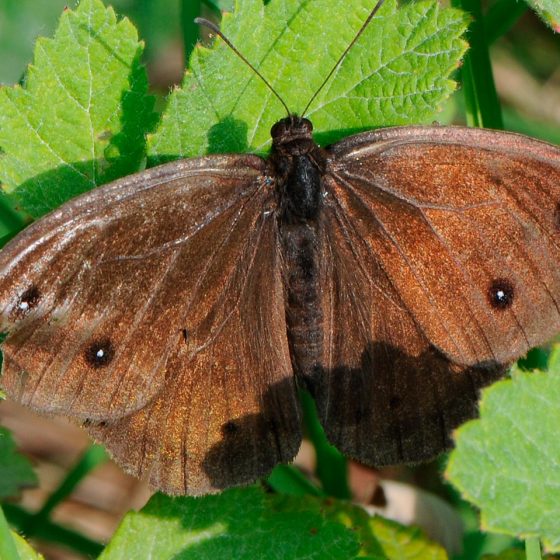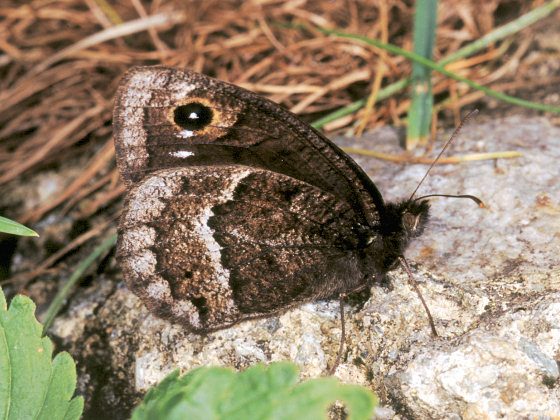Satyrus ferula – Fabricius, 1793
Descrizione
Farfalla diurna della famiglia dei Ninfalidi.
Caratterizzata da un evidente dimorfismo sessuale, il maschio di questa specie ha le ali decisamente più scure della femmina; per questo nei maschi le 2 macchie ocellate scure con punto centrale bianco, che caratterizzano in generale la specie, si confondono con il colore delle ali: di queste macchie, pertanto, emergono i soli centri bianchi.
Nelle femmine le due grandi macchie ocellate scure con centro bianco emergono bene dal fondo più chiaro e sono racchiuse in una fascia arancione, peraltro non particolarmente evidente.
Sulla pagina inferiore delle ali posteriori di questa specie si distingue bene una fascia chiara screziata di scuro.
L’apertura alare è di circa 5,5 – 6,5 cm.
La ferula è una specie molto localizzata, presente sia nelle Alpi, sia negli Appennini, sino in Aspromonte, dai 700 m fino ai 2000 m di quota.
Ha una sola generazione annuale, con sfarfallamento tra metà giugno ed agosto.
Specie orofila xero-termofila è polifaga e si ciba di diverse specie appartenenti alla famiglia Graminacee (come ad esempio Festuca, Stipa, Deschampia ecc.).
Specie simile
Minois dryas – Scopoli, 1763
- Specie tipica dell’Europa centrale e centro-orientale, non è presente nelle nostre aree
- I centri delle macchie ocellate scure sono azzurri e non bianchi
Galleria
 Link da Moths and Butterflies of Europe and North Africa [www.leps.it]: Satyrus ferula – Fabricius, 1793
Link da Moths and Butterflies of Europe and North Africa [www.leps.it]: Satyrus ferula – Fabricius, 1793
Contents
Satyrus ferula
| Satyrus ferula | |
|---|---|

| |
| Female, ventral view | |

| |
| Male, ventral view | |
| Scientific classification | |
| Domain: | Eukaryota |
| Kingdom: | Animalia |
| Phylum: | Arthropoda |
| Class: | Insecta |
| Order: | Lepidoptera |
| Family: | Nymphalidae |
| Genus: | Satyrus |
| Species: | S. ferula
|
| Binomial name | |
| Satyrus ferula Fabricius, 1793
| |
Satyrus ferula, the great sooty satyr, is a butterfly of the family Nymphalidae.
Description
The length of the forewings is 25 to 30 mm. This species shows an evident sexual dimorphism and the males are much more close to each other in appearance than the females. The wings of the males are usually dark brown on both surfaces, while in the female the wings are paler, with broad greyish bands on the undersides of the hindwings. On both sides of the forewings they have two-four black ocelli with white pupils, the first one much larger than the lower ones.
The flight period extends from June to early September and the butterflies lay their eggs on the grass. The larvae are recorded as feeding on various grasses, including Stipa, Festuca, Bromus erectus and Deschampsia caespitosa. (Higgins, Riley, 1982)
Distribution
It is found in southern Europe, Morocco, Asia Minor, Iran, Kazakhstan, Central Asia, Transbaikal, western China and the Himalayas.
Habitat
This species prefers grassy, rocky areas, calcareous grasslands, forest clearings at an elevation of 400–1,800 metres (1,300–5,900 ft) above sea level (up to 3000 m in North Africa).
-
Mounted specimen
-
Dorsal view
-
Habitat of Satyrus ferula (Val Noci, Genoa, Italy, about 500 m a.s.l.)
References
- Lionel G. Higgins and Norman D. Riley (1988) Field Guide to the Butterflies of Britain and Europe Collins, London
- "Satyrus Latreille, 1810" at Markku Savela's Lepidoptera and Some Other Life Forms
- Fauna Europaea
External links


![Satyrus ferula, femmina [da wikimedia, foto di Hectonichus Own work, CC BY-SA 3.0, commons.wikimedia.org/w/index.php?curid=20339879]](https://www.treviambiente.it/ambienteebiodiversita/wp-content/uploads/sites/9/2016/11/Satyrinae_-_Satyrus_ferula-01-femmina-wikimedia-560x560.jpg)
![Satyrus ferula, maschio [da wikimedia, by www.invertebradosdehuesca.com www.invertebradosdehuesca.com/2011/08/satyrus-ferula-negra-mayor.html, CC BY 3.0 es, commons.wikimedia.org/w/index.php?curid=18766091]](https://www.treviambiente.it/ambienteebiodiversita/wp-content/uploads/sites/9/2016/11/Satyrus_ferula1-maschio-wikimedia-560x560.jpg)






